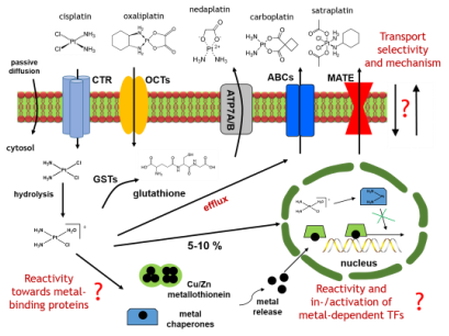BIOINORGANIC (MEDICINAL) CHEMISTRY:
Metal transport and Reactivity
In our lab, we investigate at a molecular level the chemistry of essential transition metals and metal-based drugs in biology.
We study the structure and function of trans-membrane metal transporters involved in metal translocation across biological membranes, as well as the principles of metal-complexes reactivity towards intracellular biomolecules.
RESEARCH PROJECTS:
Bioinorganic chemistry of metal transporters
Transition metal transport across biological membranes is mediated by an array of transmembrane proteins belonging to a number of transporter families that regulate the net flux of metal ions between the extracellular/lumenal and intracellular environment. This transport processes tightly regulate essential transition metal concentrations to meet cellular requirements without reaching toxic levels.
On the other hand, these transporters are also responsible for the transport of non-essential metal coordination complexes, such as platinum compounds, which are used effective chemotherapeutic agents. The mechanisms leading to impaired uptake and/or decreased cellular accumulation of metal-based drugs compounds appear crucial in determining efficacy, toxicity and resistance.
We study transmembrane protein transporters involved in the translocation across biological membranes of essential transition metals and metal-based complexes (platinum, ruthenium, gold etc.) utilized as metallodrugs.
Potential influx and efflux transporters of our interest include copper transporter proteins (CTRs), organic cation transporters (OCTs), multidrug and toxin extrusion proteins (MATE), ATP-binding cassette multidrug transporters (ABC transporters) and copper-transporting P-type ATPases.
We utilize an array of complementary biochemical and biophysical techniques to characterize purified transporters structurally and functionally, and analyze their reactivity towards different metal complexes.
We aim to reveal the molecular principles underlying metal recognition and transport, and provide the bases for rational design of new coordination compounds with better transport and reactivity properties.
Molecular principles of metal-based drug reactivity
Metal-based drug inactivation upstream of DNA binding, mediated by metal-binding to biomolecules including glutathione, metallothionein, metal chaperones and metal dependent transcription factors, represent a major component modulating efficacy and resistance towards metal-based complexes.
In a structural bioinorganic chemistry approach we address:
Bioinorganic chemistry of metal transporters
Transition metal transport across biological membranes is mediated by an array of transmembrane proteins belonging to a number of transporter families that regulate the net flux of metal ions between the extracellular/lumenal and intracellular environment. This transport processes tightly regulate essential transition metal concentrations to meet cellular requirements without reaching toxic levels.
On the other hand, these transporters are also responsible for the transport of non-essential metal coordination complexes, such as platinum compounds, which are used effective chemotherapeutic agents. The mechanisms leading to impaired uptake and/or decreased cellular accumulation of metal-based drugs compounds appear crucial in determining efficacy, toxicity and resistance.
We study transmembrane protein transporters involved in the translocation across biological membranes of essential transition metals and metal-based complexes (platinum, ruthenium, gold etc.) utilized as metallodrugs.
Potential influx and efflux transporters of our interest include copper transporter proteins (CTRs), organic cation transporters (OCTs), multidrug and toxin extrusion proteins (MATE), ATP-binding cassette multidrug transporters (ABC transporters) and copper-transporting P-type ATPases.
We utilize an array of complementary biochemical and biophysical techniques to characterize purified transporters structurally and functionally, and analyze their reactivity towards different metal complexes.
We aim to reveal the molecular principles underlying metal recognition and transport, and provide the bases for rational design of new coordination compounds with better transport and reactivity properties.
Molecular principles of metal-based drug reactivity
Metal-based drug inactivation upstream of DNA binding, mediated by metal-binding to biomolecules including glutathione, metallothionein, metal chaperones and metal dependent transcription factors, represent a major component modulating efficacy and resistance towards metal-based complexes.
In a structural bioinorganic chemistry approach we address:
- the principles governing metal-complexes reactivity towards cytosolic metal binding proteins as a function of metal ligands
- the reactivity of metal-complexes towards metal-dependent transcription factors at a molecular level
- the molecular determinants regulating metal-dependent transcription factor in-/activation induced by metal-complexes (e.g. zinc fingers) and the effects on DNA binding.

